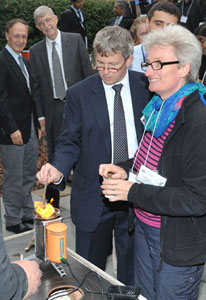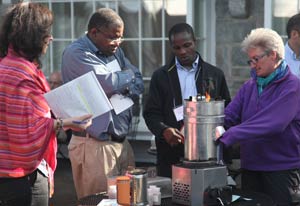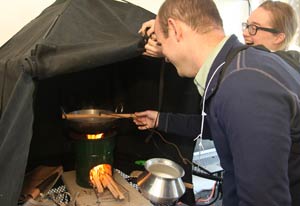NIH holds cookstove research training workshop
November / December 2012 | Volume 11, Issue 6

Photo by Michael Spencer
for Fogarty/NIH
NIH director Dr. Francis Collins
(second from left) discusses indoor
air pollution with Dr. Bill Martin of
NICHD while observing a cookstove
demonstration with workshop
participants and other guests.
By Cathy Kristiansen
Simply preparing the family meal poses a deadly health hazard in much of the developing world. Household cooking and heating fires contribute to almost 2 million deaths annually, with women and children most affected by breathing in toxic smoke for hours a day.
Solving this age-old problem is surprisingly complicated, requiring many more steps than buying off-the-shelf cookstoves and distributing them. There are numerous new types of devices that use a variety of fuels, yet little is known about how much they actually improve air quality or benefit health.
To develop more expertise in indoor air pollution research, the NIH recently hosted a three-day training workshop. Faculty experts from academia, nongovernmental organizations, the NIH and other government agencies gave lectures and hands-on demonstrations of cookstoves and emissions testing to about 20 trainee scientists from the U.S. and seven developing countries.
"Most people are still unaware of what an important issue this is," NIH Director Dr. Francis S. Collins said at the workshop's opening session. "Yet here is a situation that we can do something about, not that it's going to be easy. We clearly have a path going forward to make a difference and save many lives."
Traditional cookstoves and open fires used in cooking food, boiling water and heating homes burn dung, wood, charcoal, rice husks or other cheap fuels. The resulting smoke, often intensified by poorly ventilated rooms, can cause the same risk for disease as a lifetime of smoking and is blamed for lung cancer, acute pneumonia and chronic obstructive pulmonary disease. Scientists suspect exposure plays a role in many other health problems, ranging from low birth weight and asthma to cataracts and burns, but more research is needed on linkages. Women and children can also face physical threat while out alone gathering fuel.

Photo by Jeff Gray for Fogarty/NIH
Workshop attendees, including 20 from developing
countries, learn about clean stove and fuel options that
could help avert nearly 2 million deaths annually from
toxic indoor smoke. Research is essential to identify
how best to replace traditional stoves and measure the
health impact.
The workshop's sessions examined technical issues such as combustion efficiency, proper ventilation and accurate emissions measurement, as well as behavioral aspects involved in encouraging households to adopt clean-burning stoves. The appliance must be easy to use and reliable, or it might be abandoned in frustration. The design must also incorporate cultural preferences, for instance if the stove is to be used for rice or tortillas, or for cooking one dish at a time or several. People need to be educated about the health benefits and trained in correct operation. The fuel choice is also important since it must be inexpensive and readily accessible. Chimneys, fans, location of the stove and safety issues require evaluation as well.
"Research is going to be essential and this is where NIH has a critical role to play," Collins told the workshop. "You have to understand the whole host of issues that relate to the acceptability of new kinds of cookstoves in place of the open fires. And that means we have to understand communities and cultures and we have to be able to understand engineering. We need to measure a reduction in exposures so we have confidence that it's going to result in a better health outcome."
Clean cookstoves not only offer health benefits but can also free up women and children's time for education and other activities, improve the environment with reduced emissions and bring economic benefit through local industry involvement.

Photo by Jeff Gray for Fogarty/NIH
Workshop attendees use scientific tools to measure
combustion efficiency and emissions in a new
cookstove. Toxic smoke causes lung cancer, pneumonia,
asthma and many other health conditions.
Workshop participants were able to study 20 various types of stoves on display and observe a number of them in operation. Sessions included discussions of research design approaches, data needs and the challenges posed by intervention studies. Participants then applied the information by working in small groups with faculty mentors to develop study designs that could help fill existing research gaps.
The NIH has supported studies on the health risks of indoor air pollution for several decades. In 2010, it joined the Global Alliance for Clean Cookstoves, a public-private partnership launched by Secretary of State Hillary Clinton. The Alliance plans to have 100 million homes adopt clean and efficient stoves and fuels by 2020. The U.S. government has committed more than $50 million to the effort, including about $25 million in NIH–funded research projects.
The workshop was organized and hosted by Fogarty's Center for Global Health Studies, a trans-NIH incubator for crosscutting global health projects. The event's partners included the National Institute of Environmental Health Sciences, National Institute of Child Health and Human Development, National Heart, Lung and Blood Institute, USAID, Environmental Protection Agency and Global Alliance for Clean Cookstoves.
More Information
To view Adobe PDF files,
download current, free accessible plug-ins from Adobe's website.